Moving Cattle out of Pens and Sorting
(Updated December 2018)
Handler Movement Patterns for Moving Cattle out of Pens and Sorting
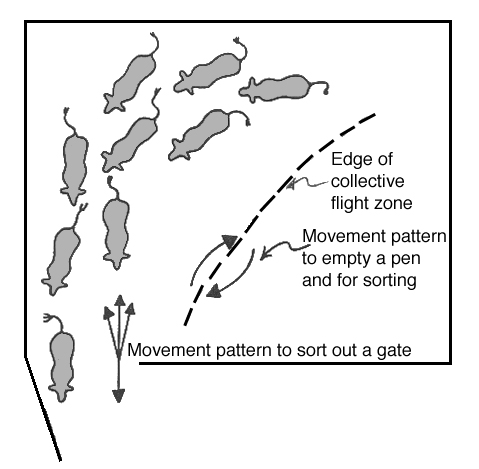
Handler positions for emptying a pen and sorting at a gate: The handler should control the movement of cattle through a gate. DO NOT let cattle run wildly through a gate. They need to learn that you control their movements. When cattle are being sorted out through a gate, stare and look at the ones you want to hold back and turn your eyes away from the animals you want to move through the gate. A hard stare is preceived as a threat.
Curt Pate, a cattle hanlding specialist, has the following tips for sorting cattle out of a pen and through a gate:
- Work the nose, because cattle go where the nose is pointed.
- Get the animal you wish to sort through the gate to look at you with both eyes before attempting to move it through the gate. This relieves pressure on the animal before you attempt to direct it through the gate.
- When cattle are handled in a single file chute (race), the balance point will be at the shoulder. When they are worked on a pasture or in a pen, the point of balance will move forward and be closer to the eye. When cattle are handled calmly, the balance point will move forward, but it will never be in front of the eye.
- By alternately penetrating and then backing out of the flight zone you can carefully "test" to determine the correct angle and spot to move an animal.
2018 Update
Cattle Sorting Tips
"Cattle want to see you" according to Ron Gill, Texas A&M University. They will turn and look at you when you are just outside of their flight zone. There are many different names for this zone, such as pressure zone, zone of awareness, or zone of influence. Cattle handling specialist Curt Pate explains that groups of cattle can be easily sorted through a gate by using a combination of "driving pressure" when the flight zone is entered and "drawing pressure" when the handler is just outside the boundary of the flight zone. The cattle will want to watch and walk towards the handler. A skilled person can sort cattle by carefully alternating between "driving pressure" and "drawing pressure" to sort individual cattle from the others.
Handling Groups: Driving Versus Leading
There have been many discussions on whether cattle should be driven or led. In feedlots, cattle handling specialists Ken Sullivan in Australia and Tom Noffsinger in Nebraska are teaching feedyard employees to lead cattle instead of drive them. Sullivan teachers people to lead new arrivals to show them where the feed and water is located. Many ranchers who often switch pastures will also lead their cattle. Leading works well when people take the time to develop trust with their cattle. Good stockmanship required patience and time to learn. However, it is recommended to teach cattle how to drive in and out of pens. This will prevent them from becoming stressed when they are taken to an auction, feedlot, or meat plant. The minimum driving skills they need to learn are moving down a wide alley and entering and exiting pens. This will train them how to move when they are taken to a new place where driving is used.
Training Cattle for On Foot and On Horse Handling: Cattle that have never seen a person on foot will havea small flight zone when moved by a person on a horse and a large fligth zone when they see a person on foot. Curt Pate staes that the best way to get cattle accustomed to people on foot is to lead a horse and then gradually move away from the horse. If the cattle start to get wild, the person moves back towards the horse. It is important to get cattle accustomed to being moed by people on foot before they leave the ranch. This will make them safer to handle when they are sold at an auction or when they go to a feedyard where all the handling is done by people on foot.
T-Square Pattern for Moving a Group out of a Large Pen
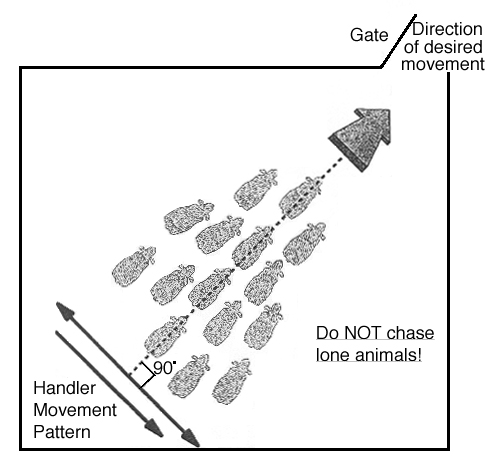
Step 1: Moving a group of cattle towards a gate in a large feedlot pen, paddock or pasture. The handlers movements, back and forth behind the group, should be at a 90' (right) angle to the direction of the desired movement. The handlers movements are perpendicular to the animals movements. Imagine that you are moving back and forth on the cross bar of a giant T-suare.
Work on the edge of the flight zone. Use the principle of pressure and release. When the cattle start moving, back off and reduce pressure on their collective flight zone. Increase pressure when they slow down. Wild running is prevented by using pressure and release.
Moving a Group out of a Large Pen Using the T-Square Movement Pattern
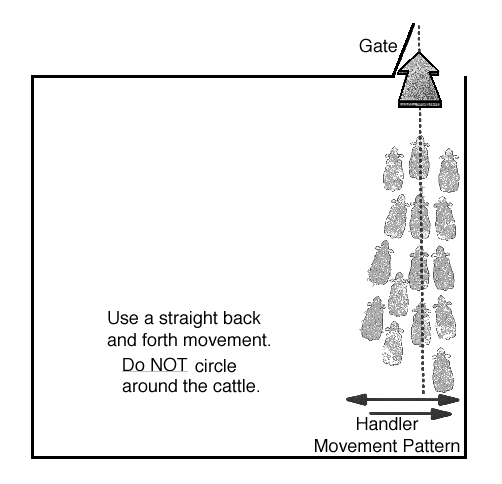
Step 2: As the group of cattle approaches the gate, the handler must shift his position to head the cattle out of the gate. Remember, calm cattle are easier to handle. All movements are done at a walk and handlers shoul be silent with NO yelling or whistling.
If cattle become excited it takes 15 to 30 minutes for them to calm down.
Correct Method for Moving a Group Out of a Large Pen or Small Pasture With Two Handlers
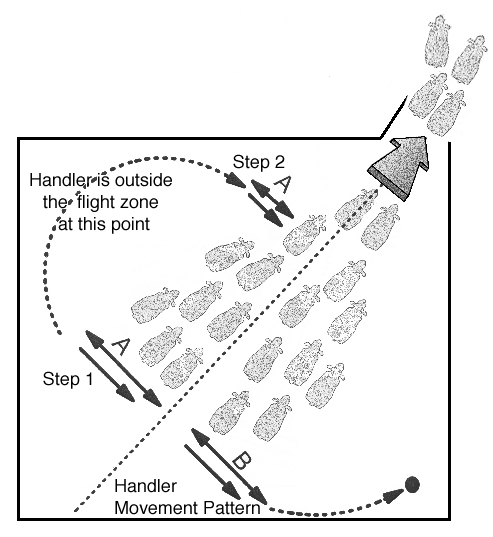
Step 1: Both handlers in the rear in a straight line. T-square position moving the animals toward the gate.
Step 2: When the animals start out the gate, handler A moves near the gate to control animal movement out the gate. A handler near the gate can control cattle flow through the gate. This prevents damage to fences.
Wrong Method for Moving a Group Out of a Large Pen or Small Pasture With Two Handlers
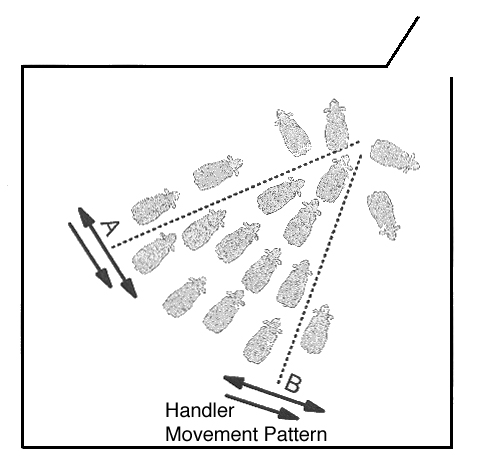
This technique is wrong because the animals receive conflicting signals
from two different handlers.





